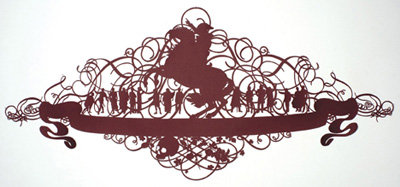6/4/2007
Two solo shows
Rare, New York
Dylan Graham presents new hand-cut paper works that exhibit a superlative technique of the most intricate virtuosity. Kyle Mosholder's work is a a sculptural installation and a monumental print dialogue in a very personal investigation, as the artist meditates on the circumstances surrounding an accident.

Kyle Mosholder + Dylan Graham
Kyle Mosholder
Much of Kyle Mosholder's previous work has been performance based but in RARE PLUS he presents his first public performance. In In Response to the Broken Arm (2007), a sculptural installation and a monumental print dialogue in a very personal investigation as the artist meditates on the circumstances surrounding an accident that led to a debilitating personal injury. Representative of the event, and not a literal recreation, a hand-carved foam wave propels the artist via a hydraulic lever onto an inflatable plastic cushion reminiscent of those used for waterborne recreational activities.
The change of the sculpture's shape created by the lever signifies a passage of time and serves as a symbolic bridge between the accident and recovery. The wall piece, originally a textbook from the `50s to teach teenagers about physics and energy, has been edited by omission as a way to convey the artist's message most directly. It gives a contextual meaning to the mechanics of the sculpture and ultimately the natural physical forces that were at play during the accident - the catalyst for the creation of the installation.
-----------------
Dylan Graham
New Zealand-born Dutch artist Dylan Graham presents new hand-cut paper works that exhibit a superlative technique of the most intricate virtuosity. The cutouts depict silhouettes of three-dimensional forms held together by a repetitive grid with filigree-style embellishments. Opting not to use high-tech processes, he allows his hand to show through the ornately decorated narrative grids that follow in the folk art tradition of papel picado, or perforated paper.
Graham also deals with the same age-old formal concerns as architects and sculptors. There is an inherent natural balance and harmony in every work resulting from his struggle between what to leave in and what to take out. Meticulously and minimally executed from a single sheet of paper, each work exhibits a light and decorative delicateness that stands in stark contrast to the heavy burden of its content. Continuing to address issues of colonialism, forced migration, and servitude, Graham's gaze has expanded to include broader historical events that examine class, politics, and world war. He explores the impact of these events from a personal perspective and how that in turn affects the collective society on a massive scale. The repercussions of how colonialists, explorers, and settlers manipulated their logic/reasoning to justify inhumane practices are still being felt today.
The title of Graham's Rain Follows the Plow (2007) is taken from a now debunked theory of Climatology that was popularized in the late 19th century and, like Manifest Destiny, fueled American settlers' westward expansion throughout the Great Plains. It was said that settling and cultivating arid regions would affect an area's humidity and ultimately render it fertile, but in reality poor agricultural practices in the US led, in part, to the Dust Bowl of the 1930s. This work represents the consequences of settling the West and depicts in a dramatic, almost biblical, scene how utterly helpless people futilely cope in the face of disaster.
Surrounded by a border of intertwining patterns of lace and grapevines (a reference to Steinbeck's The Grapes of Wrath) stands a large group of people on wide, flat ground amid broken fences, defunct windmills, and derelict houses. Amid a preacher's admonition and the distraction of music, a mixed crowd argues or flees with its possessions, and a young boy aims a stick to the sky as if it were some magical weapon to quell the tempest. At the top of the massive swirling dust storm cloud sits a group of gods observing the imminent cataclysm.
Image: Dylan Graham
Rare
521 West 26th Street New York



